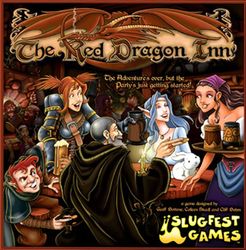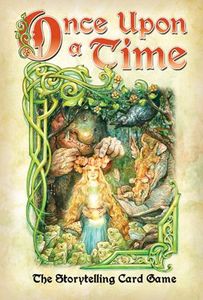
GAME DESCRIPTION: The Red Dragon Inn is a card game for 2 to 4 players (with additional players depending on expansions) published by SlugFest Games.
SET-UP: Each player takes a board, and 1 red and 1 clear token. Place the Red token on the 20, which represents your Fortitude, or health. The clear is placed on the 0, and represents your Alcohol level. Each player takes a character deck, and places it in the deck area, and draws 7 cards. Shuffle the Drink deck and place it in the middle, and give each player 10 gold coins.
TURNS: Each player follows the turn order on the board. First, the player may discard any cards from their hand, and draw back up to 7. Then, the player may play 1 action during the Action phase. The player then goes to the Order Drinks, and gives any other player a Drink card from the deck face-down without looking at it into their Drink Me! pile. Finally, the player Drinks the top card from their Drink Me! pile.
TYPES: There are several types of cards in this game, all located at the top. The first is Action, and only one can be played by the current player on their turn per turn. Anytime cards can be played...well, anytime, and Sometimes cards can only be played in response to an appropriate effect.
GAMBLING: "Gambling? I'm In" cards are also a standard action. Gambling is a mini-game where each player tosses in a coin into the "pot" for the ante, and the current player is in control. The next player may play any Gambling or Cheat card in their hand, and control passes to them. If a player cannot or chooses not to play a card, they "pass". If a round goes where all players pass and it goes back to the player who was in control, they win the pot.
DRINKS: There are several types of drinks. Most either raise the players Alcohol level, or lower their Fortitude. Some are events, where players are forced to follow an effect on the card, and the cards involved are usually drawn from Drink deck. Chasers, or drinks with a plus next to the number, force the player to draw the next drink from their Drink Me! pile, or ignore if there are none. If, however, there are no drinks during the Drink phase, the player starts to sober up and loses 1 Alcohol level.
KICKED OUT: If a player has run out of gold either at the end of a gambling session, or during normal play, they are eliminated, and kicked out of the Inn. If a players Fortitude and Alcohol level ever match or pass, they become too drunk and are kicked out. Half that player's gold is distributed among the rest of the players, and the other half, and any remainder, is given to the inn. The last remaining player wins. If there are none, everyone loses.
CONCLUSION: Red Dragon Inn is a competitive, back stabbing, revenge seeking kind of game. It's a great laugh with a solid theme. The first set might not seem like much, as the cards don't differ much between characters, but the later editions add much more chaos to the game. This is an Expandalone, or a game that can stand on its own, or be added into other versions of itself, like Munchkin. This is the kind of game that can be easily frustrating if you allow it, or a lot of fun if you can get past that initial barrier. The fun comes from the vindictive nature of the game, and plotting who should get out first. Just make sure when you start, you don't make enemies too quickly.
AFTERTHOUGHTS: The one thing that I will not do, but has been mentioned, is a real drinking game. A couple of my friends are going to attempt it, and it seems like there's some real thought being put into the game. If this strikes your fancy, go ahead, it appears to be just the thing to make the game just that more crazy. Remember: Drink Responsibly, don't drink and drive, and be safe.





